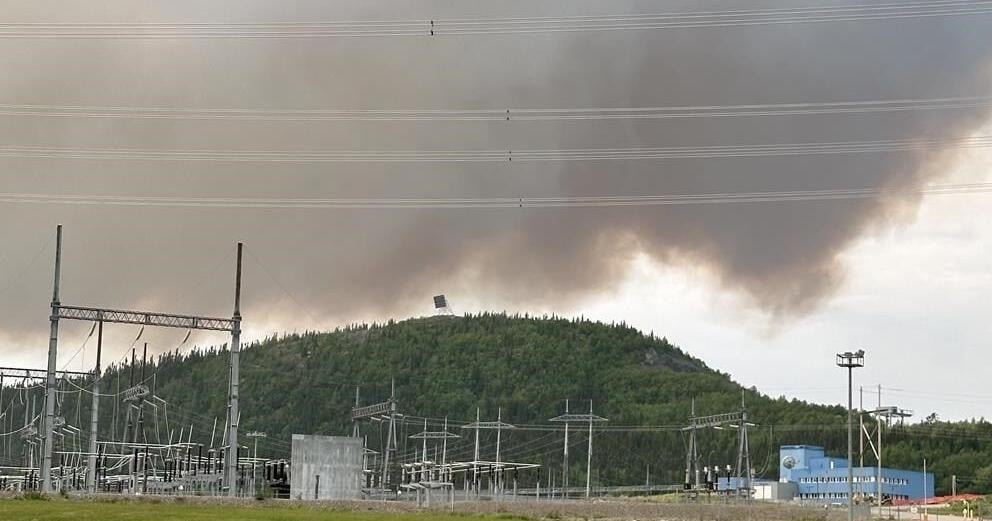ST. JOHN’S, N.L. – Power was restored Wednesday to two iron-ore mines and a small community in western Labrador after a ferocious wildfire jumped across a river and advanced quickly toward Churchill Falls, which is home to a massive power plant.
The wildfire knocked out power from two of the plant’s transmission lines on Tuesday afternoon, cutting off electricity to the region of Labrador West, which includes the towns of Wabush and Labrador City.
On Wednesday afternoon, there was a break in the smoke and the flames long enough for workers with Newfoundland and Labrador Hydro to reach the power plant by helicopter and get in to restore power, said Jill Pitcher, a spokesperson for the Crown-owned energy company.
They managed to reset one of the lines, turning the lights back on for many in Wabush, who had been without electricity for more than 24 hours.
Meanwhile, Labrador City was still getting power from Fermont, Que., though Pitcher said residents were being asked to conserve as much energy as they could.
Wednesday provided some much-needed rain and relief from high winds that had been driving the flames closer to the community of Churchill Falls, in central Labrador, Newfoundland and Labrador Premier Andrew Furey said during a news conference in St. John’s.
“We are finally getting some co-operation from Mother Nature,” Furey told reporters. “(The fire) still remains about three kilometres from the town, and the weather conditions are favourable such that the wind pattern, in particular, should keep it away.”
The blaze forced some 750 residents and workers to flee Churchill Falls last week, but a skeleton crew had remained at the generating station, which serves Labrador and Quebec. On Tuesday, they too had to be evacuated as the winds once again pushed the flames forward toward the community.
The fire advanced swiftly toward the town’s airport, hurtling across a two-kilometre lake to get there, and then barrelling over the tarmac, Furey said. At one point, it was advancing at a rate of about two kilometres per hour.
Remarkably, aerial surveys Wednesday morning showed the buildings around the airport were still standing, the premier said. The fire also did not reach the community of Churchill Falls.
“It just speaks to the energy and the force of nature that a forest fire actually is … able to jump a two-kilometre lake and jump an airstrip and not touch anything in between,” he said.
It’s not yet clear what kind of damage caused the power outages in Labrador City, Wabush and the nearby mines owned by the Iron Ore Company of Canada and Tacora Resources, said Jennifer Williams, president of Newfoundland and Labrador Hydro. The IOC mine, as it is known, had to reduce operations, and the Tacora mine was shut down entirely, according to spokespeople from those companies.
As of early Wednesday evening, their power was back on, Pitcher said, thanks to the workers who were helicoptered in to the generating station.
Williams said the final evacuation of the plant on Tuesday night was hard on the employees. “It was a lot for them to drive away. It’s their baby, I would suggest,” she said.
The Churchill Falls plant, which started delivering commercial power in 1971, is being run remotely from Happy Valley-Goose Bay, a three-hour drive to the east.
In the meantime, hundreds of people who fled Churchill Falls last week are still waiting for word on when they might be able to return home. Many fled to Happy Valley-Goose Bay, which has a population of about 8,000 people. Others drove two-and-a-half hours west, to Labrador City, which is home to about 7,450 people.
On Wednesday morning, people in Labrador City were also playing host to people from Wabush, before the power was restored later that day. The outage had affected the town’s water pumping system, and officials asked residents to start boiling their water.
The local Iron Rock Brewery invited Wabush residents to fill up their jugs with clean water at no cost, and a non-profit fitness organization, Work Out World Inc., offered showers to anyone needing them. “We’re just going to help as many people as we possibly can,” manger Teri Batlett said in an interview.
This report by The Canadian Press was first published June 26, 2024.

























